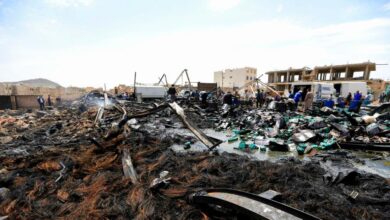Saudi tightens its blockade on Yemen by closing Almahra port

After the Saudi-Emirati military alliance closed all land, sea, and air ports in Yemen, and imposed a severe siege on the country where more than 70% of its population suffered from poverty, the ports of the Al-Mahra Governorate, bordering the Sultanate of Oman, formed a limited glimmer of hope for the Yemeni commercial sector and the movement of import and export for travellers.
However, these ports witness a state of turmoil, as a result of the Saudi invasion of the second largest Yemeni governorates, despite its distance from the ongoing war in the country. The strategic commercial port of “Shehn” was stormed a few days ago, which disrupted movement there, in order to complete the suffocation of Yemen’s commercial and economic arteries.
Saudi policies have led to a popular escalation of the Mahra tribesmen who reject this mysterious presence in their areas.
This land port is the most crowded and used in Yemen by people seeking to travel and receive treatment abroad, and about 65% of the goods imported into Yemen pass through it.
The length of the distance and the ruggedness of the roads made the Mahra crossing favoured for many merchants and businessmen, in light of the closure of dozens of land and sea ports in all Yemeni regions, and the control of Saudi and Emirati forces on airports in Mahra, Hadramout and Aden, and the closure of dozens of other airports.
The head of the sit-in committee in Al Mahrah’s Shaheen Directorate, Hamid bin Zabnout, said that all goods, food, as well as cars and equipment were obstructed, despite their prior approval by the port administration, indicating that the customs administration at the port had been attacked by the Saudi forces.
Zabnout added that Al-Mahrah was enjoying security and peace, but since the Saudi forces came to the governorate, they have been trying to work to destabilize and stir up strife in order to threaten internal peace.
Saudi Arabia entered Mahra, which iss far from the ongoing war in Yemen, in mid-2018, with a large military force. The Saudi forces stationed in a number of vital economic sites and facilities, such as “Al-Ghaydah” airport, and launched a road project linking Mahra with Saudi Arabia through a line extending from the “Saihut” area, South of Mahra, to the Al-Wadiah border crossing with the Kingdom in the Al-Abar region, north of Hadramawt Governorate, located in southeastern Yemen.
The head of the sit-in committee at Shehn Port revealed that new buildings had been constructed near the port by the Saudi forces under the pretext of reconstruction, which raises many doubts.
Zabnout confirmed that it greatly affected the movement of the port by disrupting the commercial movement and alienating the merchants who had to resort to the windows of deposit with Saudi Arabia.
In light of the recent tensions, the Yemeni government took the initiative to send the Deputy Prime Minister and Acting Minister of Transport, Salem Al-Khanbashi, to Al-Mahra Governorate, on a visit that included many local facilities, including some of Al-Mahra’s land ports.
He visited the Sarfait border crossing to see its needs, commercial movement there, the nature of work and customs procedures at the port, which also connects Yemen with the Sultanate of Oman and plays a major role in supplying the state treasury with customs revenues, according to what the Vice President of the Yemeni government confirmed.
Activist Qais bin Abboud, who is from Al-Mahra governorate, said: “Al-Mahra has turned as if it was the focus of conflict and war in Yemen, despite it being thousands of kilometres away from the ongoing conflict in the country.”
He added that “people’s lives, interests and businesses have been disrupted by what this unjustified Saudi presence has created, as many fishermen abandoned their businesses, and many commercial businesses fell into depression after their area of movement was paralyzed, in addition to pushing merchants and businessmen to leave the governorate and abroad.
According to Ali Issa, a member of the General Union of Yemeni Chambers of Commerce and Industry, the alternative to Al-Mahra outlets in the current circumstances is very expensive, due to the high bill for transporting goods, for example, through the Al-Wadiah outlet with Saudi Arabia for the distance and rugged road that leads to the continuous stopping of cargo trucks before they reach their destination, Especially when this destination is the northern governorates of Yemen.
The two countries of the coalition (Saudi Arabia and the UAE) have imposed, for five years, strict control over the ports and commercial movement at these ports.
Al-Mahra enjoys great Saudi interest, which made it one of the most important goals that prompted the Kingdom to form an alliance for the war in Yemen, according to analysts.
Saudi Arabia has tried for decades to control a port on the Arab Sea, in order to build a pipeline to transport its oil due to the longstanding disputes with Tehran in support of the Houthis, and also in light of the continuous Iranian threats to cut off the way to oil supplies through the Strait of Hormuz.
The Saudi moves come despite the fact that it has a pipeline of 1,200 km long and extends from the Abqaiq field in the eastern region of the Kingdom to the city of Yanbu on the shore of the Red Sea. However, this pipeline cannot transport more than five to six million barrels per day. A giant pipeline to transport other quantities of Gulf oil across the Arabian Sea.





